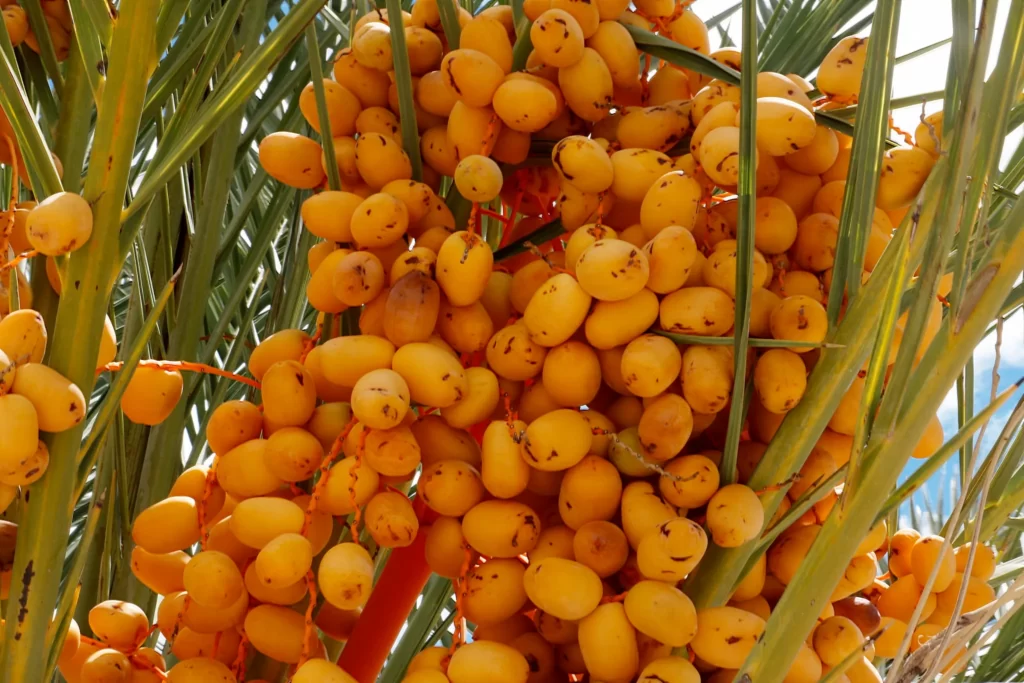Iranian dates are of different varieties and each one is used for different purposes. varieties such as Kabkab, Mazafati, Piarom, Zahedi, Astamaran, Shahani, Rabbi, Khasooyi, Barhi, Gantar, Halavi, Khasooyi, Diri, Kalooteh, etc. Among these varieties, Mazafati cultivar is perhaps the most familiar one and is mostly sold in the form of Rutab in domestic and foreign markets with a pleasant taste. Dates harvest time, depending on the type of product, is between the (end of August) beginning of September to the middle of November.
The Main Stages of Date Fruit Development and How to Preserve It
Kimri (Pahk/Pahak) Stage
When the fruit of the palm tree grows a little, it turns to light green and indeed is not edible. This stage is called Kimri and in local dialect it is called Pahk/Pahak.
Khalal (Kharak/Khark) Stage
The early fruit of the date the texture of which is almost firm and crisp and usually has a sweet and sour taste is called Kharak/Khark; It is due to the high amount of tannin (or tannoids) that the consumers feel its astringent taste. A small amount of the date varieties is harvested at this stage before they are fully ripe (for instance, Barhi Kharak/Khark in Khuzestan Province) which is very sweet and thus (Kharak/Khark bunches) are suitable for export markets. Kharak/Khark is mostly yellow or red, depending on its variety. They retain their relative original and fresh state for almost a long time in case they are frozen, and should be consumed within a maximum of one month if stored in the refrigerator.
Rutab/Rotab Stage
A half-ripe Kharak/Khark which contains a high percentage of water and is very sweet and has a very soft texture is called Rutab. Rutabs are mainly existed in brown, honey (from yellow Kharak/Khark), and black (from red Kharak/Khark) color. Honey Rutab could be stored for a long time if frozen and in order to be consumed, could be kept in refrigerator for a maximum of one month. Black Rutab which is largely Bam Mazafati Rutab (Bam Mazafati Date) could be stored and consumed at refrigerator temperature (0-4 degrees Celsius) for up to one year.
Korma/Khorma (date) Stage
If Rutab remains on the tree and is not harvested, its moisture is absorbed by the tree to a large extent; that is to say, now the fruit of the palm tree is fully ripe and accordingly reaches the last stage of growth which is called Khorma/Korma. Most of Khorma/Korma when fully ripe would be harvested at this stage. At this time, the amount of sugar in Khorma/Korma is reached its maximum and its moisture and tannin content is decreased, and in terms of texture, it is softer than Kharak/Khark and relatively harder than Rutab. Almost most date cultivars at this stage can withstand temperatures up to 20 degrees Celsius and up to 35% humidity, and if they are stored in good conditions (away from direct sunlight and pollution), they would be preserved for about a year or more.
Tips:
Because dates absorb air moisture, for better preservation, it is suitable to put them in moisture-resistant packages. Although dates are not affected by ethylene, because they absorb the smell of other foods, they should not be stored with foods such as garlic, onions, potatoes, or other foods of this kind. In addition, enzymatic and non-enzymatic factors could result in the darkening of the dates. This issue intensifies with an increase in temperature and humidity. To deactivate enzymatic factors, the oxygen concentration in the environment should be reduced.

